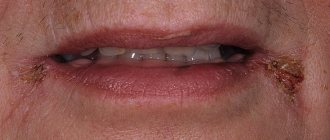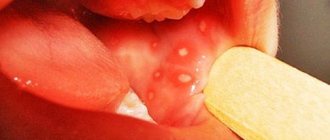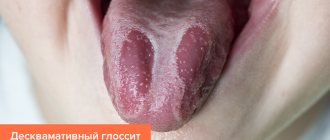- Published by: Laima Jansons
- March 7, 2017
Stomatitis is painful ulcers that appear in the oral cavity (on the inner surface of the lips, cheeks, and on the palate). Sometimes your gums can become inflamed. At the initial stage of development of the disease, small red dots appear in the mouth, which then turn into bubbles with a milky head and a red rim. Over time, ulcers form in place of the blisters. They can occur one at a time or several at once (groups of 2-3 wounds) and can cause the development of a secondary fungal or bacterial infection. The disease causes the patient severe burning pain, which makes it difficult to talk. Children with stomatitis often refuse to eat. Their body temperature may also increase.
Causes of the disease
The main factors that can provoke oral diseases, including stomatitis, include:
- mechanical damage or burn (chemical or thermal) of the oral cavity;
- ignoring basic hygiene rules;
- poor nutrition, when the body does not receive enough essential nutrients: zinc, iron, folic acid, vitamin B;
- concomitant diseases such as oncology, anemia, helminths, gastritis, colitis;
- use of incorrect or low-quality dental care products;
- unsuccessful dental procedures.
Smoking is also one of the causes of oral ulcers due to the negative effects of nicotine on the mucous membranes. Source: flickr (moiht).
Types of stomatitis
Stomatitis comes in different forms: it depends on the causative agent of the disease. So, it can have a viral, microbial or mycotic etiology. Accordingly, the symptoms, description and principles of treatment of the disease will be different.
Aphthous stomatitis: treatment
The exact reasons why this type of stomatitis occurs have not yet been established. Some experts consider staphylococci and adenoviruses to be the source of ulcers, while others attribute the disease to a viral disease. Some doctors equate aphthous stomatitis with herpetic stomatitis, with the only difference being that in the first case, instead of ulcers, aphthae appear - round white or yellow plaques with a red frame. Aphthae are concentrated on the cheeks, lips, and tongue.
The disease occurs against a background of decreased immunity and can transform into an ulcerative-necrotic form.
Treatment of aphthous stomatitis in adults is as follows:
1. Local treatment, including treatment of aphthae and rinsing the oral cavity with disinfectants and antiphlogistic agents, such as hydrogen peroxide (diluted 1:1 with water), furatsilin tablet, boric acid, sea buckthorn oil.
2. Drug therapy aimed at detoxification and desensitization.
3. Vitamin therapy.
4. Use of sedatives and antihistamines.
5. Physiotherapy.
6. Diet, which consists of excluding spicy, allergenic and rough foods from the diet.
Aphthous stomatitis in adults often occurs against the background of exacerbation of pathologies of the nervous, endocrine systems and diseases of the gastrointestinal system. Therefore, its prevention will be the treatment of concomitant diseases.
Since aphthous stomatitis is often caused by staphylococcus, a pathogen that multiplies in dental plaque and teeth affected by caries, a thorough improvement of the oral cavity is necessary. With surgical dental treatment and removal of dental plaque, the problem of aphthous stomatitis in adults is minimized.
Herpetic stomatitis: symptoms
Herpetic or herpes stomatitis is the most common form of manifestation of the disease. Almost 90% of the adult population are carriers of the herpes virus, which in itself does not cause any discomfort. But with a decrease in immunity, exacerbation of chronic pathologies or trauma to the oral cavity, it can intensify and manifest itself in the form of herpetic stomatitis.
This type of stomatitis most often affects the cheeks, tongue, and palate. The clinical description of the oral cavity will be as follows: the mucous membrane becomes swollen and red. Against this background, small rashes appear.
The disease lasts about ten days, during which the adult usually does not experience any acute reaction to the appearance of ulcers. Body temperature remains normal, no symptoms of intoxication are observed, and the person feels relatively well. In case of reduced immunity or in a child, general intoxication, malaise and high fever are possible.
Discomfort is caused only by the process occurring in the mouth, consisting of:
• formation of bubbles;
• merging them into a group;
• bursting of ulcers and the formation of painful erosion (it hurts a person to drink, eat, talk).
The disease is also often accompanied by enlarged lymph nodes.
Sometimes herpetic stomatitis can develop into gingivitis, characterized by sharp redness of the gums around the teeth. Also, with gingivitis, rashes can affect the red border of the lips. Treatment for gingivitis is problematic, so it is better to prevent herpes from developing into gingivitis.
Treatment of stomatitis consists of taking medicinal anti-inflammatory, anesthetic and antiviral drugs. It should be remembered that herpes is not sensitive to conventional disinfecting infusions, so herbs and chlorhexidine are not a help here.
Local treatment and vitamin therapy also help. It should also be borne in mind that this form of the disease is contagious, therefore, during the period of illness, close contacts associated with kissing, drinking from the same cup, etc. should be limited. This especially applies to people whose disease has progressed to gingivitis.
Candidal stomatitis: treatment
This is already a fungal manifestation of a disease that is characteristic only of people with a very weakened immune system, suffering from chronic diseases or taking steroid hormones.
The causative agent of the disease is the Candida fungus, which is always present in the oral cavity. Its reproduction and manifestation in the form of a cheesy coating and white spots begins only in the presence of provoking factors.
The treatment regimen for stomatitis in adults consists of the following measures:
• taking antifungal medications;
• treatment of lesions with antifungal gels and ointments;
• if you have dentures, treat them with antiseptic solutions;
• rinsing the mouth;
• exclusion of easily digestible carbohydrates from food;
• visiting a gastroenterologist and endocrinologist, since the disease is often caused by pathologies characteristic of these medical areas.
Catarrhal stomatitis: causes of occurrence
This is the mildest and most common form of stomatitis. Often this is where other types of disease begin. With timely rinsing of the mouth, the disease will subside within a couple of days. Otherwise, it may develop into a more severe form. The patient only has to follow one simple rule: you need to rinse your mouth for at least a minute.
Externally, the disease looks like a light coating on the mucous membrane and is accompanied by slight swelling and redness. You may also experience bad breath, increased salivation, and a severe burning sensation in the mouth.
The main reason why catarrhal stomatitis occurs is oral candidiasis, which occurs against the background of a general inhibition of the body's defenses. The causes of the disease also include:
• inadequate oral care;
• diseases in the gastrointestinal tract of a chronic nature;
• damage to the body by worms;
• dental problems – untreated caries, periodontitis, dental plaque.
Regular visits to the dentist will help eliminate the problem of the development of catarrhal stomatitis and its transition to another form of the disease.
Allergic stomatitis
Allergic stomatitis in adults is not an autonomous disease: it can accompany any allergic reaction in a person. Particularly susceptible to illness are individuals who react with allergies to food or medications when there is direct contact of the allergen with the oral mucosa. People also often react to dentures with allergic stomatitis.
Allergic stomatitis comes in several types:
• viral;
• bacterial.
It depends on the causative agent of the infection. Often, due to allergies, aphthous stomatitis can occur, which is called aphthous allergic stomatitis.
Signs of stomatitis are manifested by the appearance of white spots or small blisters in the mouth. The mucous membrane turns slightly red and becomes covered with pinpoint hemorrhages. The person may experience pain, burning, severe itching, or dry mouth.
Treatment of stomatitis comes down to taking medicinal antihistamines and eliminating the main cause of the allergy.
Prosthetic stomatitis: causes
Prosthetic stomatitis in adults manifests itself in two types: allergic and bacterial. In both cases, the clinical picture is manifested by a sharp reddening of the mucous membrane of the prosthetic bed. And with the allergic type, redness also occurs in all areas of the mucous membrane that are in one way or another in contact with plastic.
The causes of prosthetic stomatitis depend on its type:
1. Allergic
This is a common allergic reaction to dentures. The main reason for this is the monomer included in the structure of acrylic plastic, which is used in the manufacture of prostheses. Also, the reason for the body’s reaction to dentures may not be the competence of the dental technician, who committed a violation in the selection of the proportion of components in the manufacture of plastic.
Replacing a low-quality prosthesis can solve the problem.
2. Bacterial
In this case, the “owner” of the prostheses himself becomes the culprit of the disease. It must be remembered that removable dentures require the same care as teeth. They must be constantly cleaned after eating. Otherwise, pathogenic elements may form on the surface of the product, which, in addition to the proliferation of bacteria, become a source of unpleasant odor.
Therapy for denture stomatitis consists of disinfecting rinsing of the oral cavity and treating the inner surface of the denture and the mucous membrane underneath it. It is enough to apply a small layer of antiseptic to relieve the painful condition.
Vincent's ulcerative necrotizing stomatitis
The main difference between ulcerative stomatitis is the presence of large, small-sized ulcers in the oral cavity coupled with the death (necrosis) of gum tissue. The disease is quite rare and may be a consequence of untreated catarrhal stomatitis.
Favor the development of Vincent's stomatitis:
• bacterial growth due to poor oral hygiene;
• weakened immunity;
• smoking;
• previous viral diseases.
The cause of the disease is often gastric ulcers and various poisonings.
The development of pathology occurs according to the following scheme:
1. Changes in the oral cavity
The patient notices dryness of the mucous membrane, bleeding gums, the appearance of ulcers on the hills between the teeth, which are later covered with plaque. Inflammation affects the inside of the cheeks, palate, and tongue, making eating and talking painful.
2. General health
The disease is accompanied by fever, weakness, and loss of appetite. The lymph nodes may become enlarged and tender to the touch.
To treat ulcerative stomatitis, the help of a specialist is necessary. Under anesthesia, he will remove dead tissue, bacterial plaque and tartar. Otherwise, you can get exposure of the roots of the teeth and massive necrosis of the gums.
Further therapy consists of the use of antibiotics and antihistamines, disinfectant rinsing and local treatment of the mucous membrane. If necessary, antipyretic and painkillers help. A course of vitamins also has a therapeutic effect.
Stomatitis acute and chronic
Stomatitis in adults differs not only in the form of manifestation. There are also differences in the nature of the disease. So, it can be acute and chronic. The first is characterized by the following description:
• swelling and hyperemia of the mucous membrane;
• formation of ulcers, erosions and plaque.
Stomatitis transforms into a chronic form if it becomes acute. And if a person’s immunity is weak, then the causative agent of the disease remains in the oral cavity constantly even after treatment. As a result, inflammation takes on a chronic form, characterized by a sluggish course with relapses.
The most common chronic form of the disease is characteristic of herpetic stomatitis. The herpes virus, even despite complete recovery, continues to constantly remain in the nerve endings of cells and is activated at the slightest weakening of the immune system.
Microbial carious stomatitis
There is another type of major stomatitis, which is an accompanying disease and manifests itself during the development of infectious diseases - microbial carious stomatitis. The origin of the disease in this case may be related to:
1. With any dental problems that are a source of infectious processes
Tartar, caries, dental plaque - all this is a place where carious bacteria - streptococci and staphylococci - are concentrated. At the slightest trauma to the mucous membrane, carious infection leads to the development of stomatitis.
2. With scarlet fever or sore throat
Scarlet fever is accompanied by a strong white coating on the tongue, which after a few days is replaced by a bare, bright red surface of the mucous membrane. In this case, they also talk about bacterial microbial stomatitis. A white coating on the tongue also accompanies a purulent sore throat. In the case of stomatitis, inflammation spreads not only to the mucous membrane and throat, but also to the gums, which look reddened, swell and hurt.
Therapy for microbial carious stomatitis consists of antiseptic rinsing and diet.
How is stomatitis treated?
If a disease is detected, in order to avoid its development and aggravation, it is necessary to urgently visit a doctor who will prescribe the optimal course of therapy. However, there are generally accepted measures that should be followed in order to quickly get rid of an unpleasant illness:
- Isolation of the patient. It is necessary to provide him with separate dishes and personal hygiene products.
- Using pain medications to reduce pain and discomfort.
- Ventilation and humidification of the room.
- Proper nutrition. It is necessary to eliminate sour and spicy foods for a while. It is important to ensure that food is not very cold or too hot.
Stomatitis can be treated using several methods: medication, folk remedies, and homeopathic medicines.
Cooking methods
To cure stomatitis, patients often resort to alternative medicine. There are many recipes for folk remedies, but the most effective are chamomile-based infusions and decoctions. Their preparation does not require much time and effort.
Infusion
For rinsing ulcerative lesions in the mouth with chamomile, alternative medicine offers the following infusion recipe:
- you need to take a large spoon of dry inflorescences of the plant and pour 200 ml of boiling water;
- leave the liquid to infuse for 15-20 minutes;
- After the time has passed, strain the infusion through gauze folded in four layers.
You should rinse your mouth with the prepared medicine throughout the day at intervals of two to three hours, and also after each meal. The infusion should be used to prepare the oral mucosa for other medical procedures, for example, healing applications. The medicine must be prepared every day to keep the infusion fresh. With complex therapy with chamomile recipes and other remedies for painful lesions on the oral mucosa, the course duration is three to four days.
Decoction
To get rid of stomatitis, you can rinse your mouth with chamomile decoction. To prepare it, you need to take a small spoon of flowers and pour a glass of boiling water into an enamel bowl. The liquid is prepared for 15 minutes in a water bath, after which the amount of water is adjusted to 200 ml, boiled and left to infuse for half an hour.
After a while, the healing liquid must be carefully filtered and a spoonful of honey added to it. It should be borne in mind that it is necessary to add honey when the temperature of the decoction is below 60 degrees Celsius, otherwise the beekeeping product will lose its beneficial properties.
After the chamomile decoction has cooled, rinse the mouth with it in the morning, at lunch and in the evening 15-20 minutes after eating. The duration of treatment is three weeks.
Should I turn to homeopathy?
Today, more and more patients are turning to homeopathy for stomatitis treatment. This is due to the fact that homeopathy remedies do not have serious side effects like individual medications. They contain small doses of active ingredients, which prevents them from accumulating in the human body. Very often, modern parents resort to homeopathy to treat their children, since the risk of various side effects is minimal.
Causes
Stomatitis is a disease that affects the mucous surfaces of the oral cavity. This is an acute inflammatory process of various etiologies, which is manifested by the appearance of yellowish or whitish pimples with liquid and ulcers. It can occur in children and adults, but children are much more likely to suffer from the disease.
The rash affects the inside of the cheeks, gums, and tongue. Their appearance causes discomfort, since ulcerative wounds itch, hurt, and there is a constant burning sensation in the mouth.
Young children have extremely delicate oral mucous membranes. The body’s insufficiently developed defense system is not able to quickly cope with infectious agents, so the natural reaction of the immune system to their entry into the body is inflammation. Common causes of the disease are:
- insufficient oral hygiene;
- chronic gastrointestinal diseases;
- mucosal injuries;
- burn;
- ingestion of pathogenic bacteria from hands or toys.
Important! Treatment of stomatitis in children is possible at home. However, in order to choose the right treatment regimen, you cannot do without consulting a specialist.
Advantages and disadvantages
Like any other method, therapy using homeopathy has its pros and cons.
Since stomatitis is a rather complex disease, in advanced cases it should be treated not only with homeopathic medicines. Severe discomfort and pain can only be eliminated with the help of special medicine.
Homeopathy strengthens the body's defenses and prevents recurrence of the disease.
The best types of stomatitis that can be treated with homeopathy are aphthous and candidal stomatitis. Homeopathic remedies work to eliminate the external signs of the disease, as well as its general manifestations.
What homeopathic remedies are used to treat stomatitis?
There are several basic homeopathic remedies that are effective for stomatitis.
- Borax, where the basic substance is sodium borate. The action of the medicine is aimed at accelerating the healing process of wounds and erosions. The drug helps with voluntary drooling and distorted taste perception. It heals wounds on the cheeks and larynx very well.
- Kalium bichromicum. It is prescribed for severe inflammation of the mucous membrane and deep aphthae.
- Kalium muriaticum heals ulcers very well and also has a positive effect on the mucous membrane.
- Arsenicum is prescribed to patients with small aphthae that cause severe pain and discomfort.
Gingitis, stomatitis
In the treatment of superficial inflammation of the mucous membrane, the choice of the appropriate medication is based on the color of the tissue, provided that the selected medication corresponds to the significant general symptoms.
For a fresh, bright red color, Belladonna is used.
Belladonna - acute onset of inflammation with bright red mucous membrane. The mucous membrane of the oral cavity is swollen, marked redness with dryness and burning, throbbing pain. The tongue is shiny, red (raspberry tongue). Desire to drink cold drinks in small sips, although they often increase the pain. With a pronounced disturbance in the general condition, sometimes with fever, the patient sweats, the face is hyperemic, the pupils are dilated, and pulsation of the carotid arteries is visible. The drug is indicated for acute stomatitis and gingivitis.
The dark red color of the mucous membrane corresponds to Phytolacca. Phytolacca - dark color and stabbing pain indicate progressive inflammation. Later, whitish pustules can be seen on the mucous membrane, which merge to form a plaque. Indicated for stomatitis with beginning suppuration and plaque. If the mucous membrane has a bluish-red color, the use of Lachesis and Carbo vegetabilis is justified.
Lachesis - purple-red color up to cyanosis is a sign of inflammation with stasis in the capillaries and breakdown of blood elements, which leads to ulceration. Oral pain worsens from warm drinks and food. Cold foods, especially ice, reduce pain. The general condition is sharply disturbed, sometimes there is a septic course, which is manifested by fear, anxiety and increased heart rate. Indicated for stomatitis, ulcerative stomatitis, and threatening septic conditions.
Carbo vegetabilis - bluish coloration of the inflamed mucous membrane with burning pain due to slow oxidation and oxygen deficiency in the tissues. Tendency to form ulcers; ulcers bleed easily; their bottom is bluish or gray. The tongue is coated with a dirty coating. Chilliness with cold body, but need for fresh air. Indicated for stomatitis, aphthous stomatitis, ulcerative stomatitis and ulcerative membranous stomatitis. For inflammation with tissue swelling, a preparation from bees is used.
Apis mellifica - the reaction to a bee sting is manifested by bright red swelling with glassy edema and burning, stabbing pain.
This phenomenon is consistent with the pathogenesis of Apis. The inflamed mucous membrane becomes pale red due to swelling. The pain is relieved by cold drinks and worsened by hot drinks. Thirst is often slight. The drug is indicated for stomatitis with tissue swelling. Share your interest!
Homeopathy for stomatitis in children and adults
Treatment of stomatitis in children with homeopathic remedies gives excellent results, especially if you start getting rid of stomatitis at the first stage of the disease, as well as in combination with other dental procedures.
Source: flickr (Goolsby Gallery). When aphthae and wounds occur on the mucous membrane, a combination of homeopathic remedies based on borate and mercury oxide is recommended: Borax, Mercurius solubilis.
Medicines that contain Mercurius help with bad breath, excessive salivation, and swelling of the mucous membranes. These remedies also reduce pain and eliminate bleeding gums.
Arsenicum album and Acidum nitricum are used in the treatment of children with aphthous and erosive stomatitis, which are accompanied by severe pain.
As for homeopathy for stomatitis in adult patients, the principle of therapy is similar to the treatment of children. Only in this case, complex therapy is almost always prescribed (homeopathy + dental procedures + traditional medicine).
What can you eat if you have stomatitis?
Inflamed mucous membranes and ulcers in the mouth make it impossible to eat as usual. Therefore, during illness you have to change your eating habits. This is necessary to reduce discomfort, reduce inflammation and restore normal microflora. Warm food with a soft consistency that does not irritate the mucous membrane is recommended. If you have stomatitis, you can eat:
- warm fermented milk products (ryazhenka, kefir)
- compotes and jelly from fresh berries or dried fruits
- liquid porridge
- meat and fish, steamed and pureed
- soups with lean broth
- cottage cheese dishes
If a child suffers from stomatitis, the diet depends on the age of the child and the form of the disease. Give your baby warm drinks more often, which soften the mucous membrane and reduce the process of intoxication, especially after feeding. This can be a chamomile decoction or even simple boiled water. And if stomatitis occurs in an infant, then pay increased attention to sterilizing bottles and nipples and treating the breast before and after feeding. Regardless of the patient’s age, the stop list for patients with stomatitis includes:
- bread
- juices, berries and fruits
- smoked products
- spicy and highly salty foods
- chips and crackers
- fried fish and meat dishes
If you have stomatitis, you will have to temporarily change your usual diet in favor of liquid or semi-liquid foods. At the same time, you should not even eat soft bread or cookies, as they can injure the inflamed mucous membrane.










